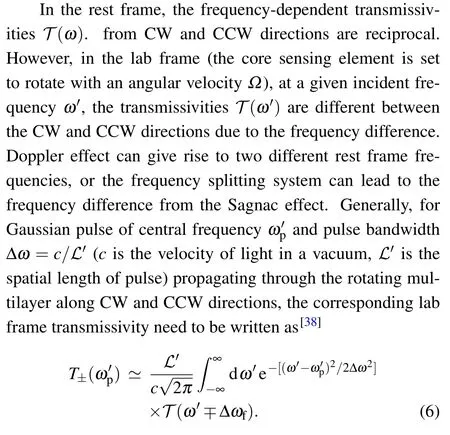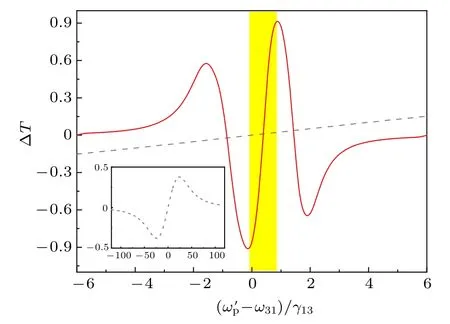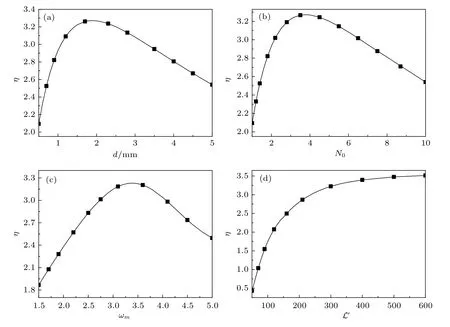Sensitivity enhancement of micro-optical gyro with photonic crystal*
2021-05-06LiuYang杨柳ShuhuaZhao赵舒华JingtongGeng耿靖童BingXue薛冰andYonggangZhang张勇刚
Liu Yang(杨柳), Shuhua Zhao(赵舒华), Jingtong Geng(耿靖童), Bing Xue(薛冰), and Yonggang Zhang(张勇刚)
College of Intelligent Systems Science and Engineering,Harbin Engineering University,Harbin 150001,China
Keywords: optical nonreciprocal effect,photonic crystal,micro-optical gyro,high sensitivity
1. Introduction
Inertial sensors for rotation such as ring laser gyros(RLG), interferometric optical gyroscopes (IOG), and microelectro-mechanical system (MEMS) gyros are now widely used in commercial and military fields. Miniaturized inertial measurement units enable small platforms for a variety of emerging applications, such as unmanned air and underwater vehicles, as well as navigation in subterranean structures. As MEMS-based sensors do not provide sensitivity that competes with optical gyros, a variety of micro-optical gyros, such as ring micro-laser gyros,[1]fiber ring resonator micro-optical gyros,[2]micro-resonator Brillouin gyros,[3,4]parity time(PT)symmetric microscale optical gyros,[5,6]non-Hermitian ring laser gyroscopes,[7]and waveguide micro-ring resonate gyros[8–12]have been recently demonstrated.
While many researchers make great efforts in microoptical gyros,the ultimate goal of high sensitivity has not been previously realized.[13,14]IOG and RLG with high sensitivities are difficult to be miniaturized,[15]so resonant micro-optical gyro (RMOG) and Brillouin micro-optic gyro (BMOG) with a chip-based optical resonator were introduced as the ideal candidates for new generation optical gyros with high sensitivity, miniaturization.[1,3,16,17]However, immature detection technique[18]and low signal-to-noise ratio[19]result in the RMOG and BMOG still in the stage of laboratory research with lower sensitivities compared with the mature RLG and IOG. Therefore, it is very important and urgent to propose a new structure or detection method to improve the sensitivity of micro-optical gyros.
Electromagnetically induced transparency (EIT),[20]a quantum interference effect induced by a strong coupling field, based on which the optical absorption of a weak probe field can be largely suppressed in a small frequency range while the large-dispersion property remains. Recently, the study of EIT has been extended to atoms confined in optical cavities[21,22]and impurities doped in photonic bandgap(PBG)materials,[23,24]and singular electromagnetic modes in cavities and at band edges may be utilized to control and modify EIT features. Petrosyan’s work[25]showed that very narrow bandgap and transmission peak might arise within the transparent window.
Great efforts have been made to achieve optical nonreciprocity, such as using media with P-T symmetry,[26–28]with acousto-optical effects[29]or magneto-optical effects,[3]using spinning resonators,[31–34]and using nonsymmetric photonic crystals.[35]Recently, it has been found that the nonreciprocal transmission can be achieved by setting the photonic crystal[36]and periodically distributed atoms into motion.[37,38]When a photonic crystal moves, the counterpropagating light is blueshifted and the co-propagating light is redshifted in the reference frame of the moving photonic crystal due to the Doppler effect.[38]
According to the working principle of RMOG, the resonance frequency difference related to angular velocity is determined by the Sagnac effect, while the detection sensitivity depends on the fineness of the resonator (namely, the slope of the demodulation curve).[11]The resonance frequency difference is fixed when the size of the resonator is defined, so improving the fineness of the core sensing element is a good way to improve the sensitivity of gyros.
In this paper, we extend the previous works[37,38]and improve the sensitivity of micro-optical gyros by using the photonic crystal.87Rb atoms driven into a three-level Λ configuration, periodically trapped into the photonic crystal,may create a sharp transmission peak of electromagnetically induced transparency. We discuss the generation of large clockwise-counterclockwise(CW-CCW)nonreciprocal transmission, which leads to improving the sensitivity of the gyro system. In addition,it is discussed that the sensitivity depends on the slope of nonreciprocal curve could be controlled by varying the atomic density,modulation frequency,probe pulse width,and photonic crystal length,etc.
2. Theoretical models and equations

where N(x)is the inhomogeneous atomic density as a periodic function of the photonic crystal length x.


Fig.1. (a) Energy level diagram form of a three-level Λ-type atomic system interacting with probe field ωp and coupling field ωc. (b) The atoms are trapped periodically with Gaussian distribution in the photonic crystal of period and length a=λ31/2 and d =na. (c) The core element for relative rotation sensing using Doppler effect with stationary source and frame, rotating medium. (d) Whispering gallery mode resonator (WGMR) setup for absolute rotation sensing using frequency splitting effect with corotating source and frame,stationary medium. The core rotation-sensing element can be composed of micro-resonators such as WGMR, waveguide-type ring resonator (WRR), and micro-fiber resonator. The radius of the micro-resonator is r.
In this photonic crystal structure,the probe field may experience PBG with transmission peak, which can be verified by utilizing the transfer-matrix method.[24]In brief, the first step is to construct a transfer matrix Mjof the j-th single period, which should be decomposed into, e.g., 100 sublayers of the same thickness δx(≪a) but of different atomic densities N(xl) with (l ∈1,100). The transfer matrix mj(xl) of each sublayer is the product of a propagation matrix with a discontinuity matrix,whose coefficients are given by the Fresnel coefficients,[41]and is related to the elementary reflection and transmission coefficients,rjand tj,as follows:

Then Mj=mj(z1)···mj(zl)···mj(z100). The second step is to attain the transfer matrix for the whole atomic sample of length d=na. Then it is easy to calculate the probe transmissivity

with M(i,j)being one matrix element of the total transfer matrix M.


From the Doppler effect,transmission peaks experienced by the CW and CCW monochromatic light of frequency ω′are shifted by ∓ω′·Ωr/c,then the frequency difference between them is

where λ is the wavelength in the core rotation-sensing element. According to the principle of the Sagnac effect,the relationship between angular rate Ω and frequency shift ∆ωsagof ring resonator can be written as

where nsis the refractive index of the resonator.The frequency difference ∆ωdopand ∆ωsagcan be used to sense the relative and absolute rotation rate, respectively. The detection of frequency difference is crucial for the sensitivity of gyro,and the sensitivity of gyro can be greatly improved by a sharp transmission peak.
3. Results and discussion
In this section, we explore, via full numerical calculations,how to generate and manipulate the nonreciprocal transmission in a coherently driven photonic crystal in terms of the sharp transmission peak. We first examine the probe transmissivity profiles in the rest frame (Ω =0) where the CW and CCW propagating transmission T+and T−are reciprocal, as shown in Fig.2(a). The sharp edges of the transmission peak,which are contributed by the coupling field, are useful to obtain the large nonreciprocal effects for a probe pulse with a full linewidth of ∆ω =1.0 MHz. Meanwhile, we show the CW-CCW nonreciprocity in Fig.2(b), where two resonance transmission peaks T+and T−are split with a frequency difference.
In order to show the advantages of our scheme in frequency difference detection, we compare the results with the traditional RMOG. For traditional RMOG, transmissivity without considering the transmission loss of optical fiber can be written as[42]

where the delay time τ=2πrns/c;Q′=C(1−αC),R′=(1−C2)(1−αC),C and αCare the coupling coefficient and the attenuation coefficient of resonator;Q=Q′e−∆ω,R=R′e−∆ω,∆ω is the linewidth of free-running laser. We show the traditional resonance curve (dashed line) with the same cavity size and laser linewidth, where the transmission peak of the photonic crystal is far sharper than the resonance curve in Fig.2(a).

Fig.2. (a)Rest frame transmissivity and(b)laboratory frame transmissivities under ωf =0.3γ for a photonic crystal. Other parameters areℒ′ =300 m, γ31 =γ32 =γ =6 MHz, γ12 =0.008γ, Ωc =2γ, ∆c =0,Nave=3.0×1010 cm−3,µ13=1.0×10−29 C·m,λ =λ31=794.969 nm and d=3.0 mm.

Fig.3. Transmission nonreciprocity parameter ∆T (red soild line)with ωm=2 MHz and demodulation curve of traditional RMOG ∆Ttra (gray dashed line and inset)with ωmtra=150 MHz as functions of the detuning of the probe central frequency ω′p/γ13 from the atomic resonance ω31.C=0.95,αC =0.01,r=1 cm and other parameters are the same as in Fig.2.

For the detection of relative rotation, although the frequency difference produced by the Doppler effect is slightly smaller than that produced by the Sagnac effect, the sensitivity resulted from the construction in Fig.1(c) is about 50 times better than that of traditional resonator gyro. The frequency difference produced by the frequency splitting effect is equal to the traditional one. Thus,for the detection of absolute rotation, the sensitivity resulted from the construction in Fig.1(d)is more than two orders better than that of traditional resonator gyro. Detecting the range of gyroscope depends on the linear region of the transmission nonreciprocity parameter∆T highlighted in Fig.3. As we can see,the frequency range is about 0.1γ. Then the detecting range is about±2600∘/s for r=1 cm,which is sufficient for the gyros.
The CW-CCW nonreciprocity from a photonic crystal mentioned above can be generated by the Doppler effect for relative rotation sensing or by the frequency splitting effect for absolute rotation sensing. The underlying physical reason for the changes in optical response is that the probe susceptibility will experience a frequency shift along the direction of rotation. The probe transmissivity and absorption coefficient of the rotating atomic ensemble will be changed due to the Doppler frequency shift or splitting frequency shift experienced by the probe susceptibility. Then, if the CW-incident probe frequency is within the EIT window,the CCW-incident frequency may locate at the absorption region,which will give rise to CW-CCW nonreciprocity in probe transmission and absorption.
It is worth noting that the existence of transmission peak and rotation-induced nonreciprocity are not unique to this photonic crystal setup. Similar nonreciprocal effects can also be achieved, for example, by using the traditional rotating PBG medium. But the nonreciprocal output is low,since the transmission peak is not sharp enough.[24]In our scheme,the slope η can be enhanced by using laser-induced quantum interference because the deeply narrow EIT window can be generated by using laser-induced quantum interference. This will further give rise to transmission peak sharp enough,which is the key to high nonreciprocal output.
In Fig.4,we further show the dependence of the slope η on the detecting sensitivity of gyro, namely, on the length of photonic crystal d, atomic density ωm, modulation frequency ωm, and the linewidth of free-running laser ∆ω. In Fig.4(a),η increases with the increase of d when d<2 mm,decreases with the decrease of d when d <2 mm, and reaches a maximum value when d is about 2 mm; In Fig.4(b), η increases with the increase of N0when N0<3.5×101cm3, decreases with the decrease of N0when N0> 3.5×101cm−3, and reaches a maximum value when N0is around 3.5×101cm−3.In Fig.4(c), η increases with the increase of ωmwhen ωm<3.4 MHz, decreases with the decrease of ωmwhen ωm>3.4 MHz, and reaches a maximum value when ωmis around 3.4 MHz. Figure 4(d) shows that η will be enhanced monotonically with decreasing the pulse linewidth ∆ω.Specifically,it increases quickly when ℒ′<300 m(∆ω>1 MHz),changes slowly when ℒ′>300 m(∆ω<1 MHz),and remains invariant when ℒ′>400 m(∆ω<0.75 MHz). Thus,the detection sensitivity of η can be manipulated by modulating the length of photonic crystal d, atomic density N0, modulation frequency ωm,and the linewidth of free-running laser ∆ω properly. The linear range highlighted in Fig.3 will also be changed when these parameters are changed. Then we need to consider both the sensitivity and measurement range when modulating the parameters.

Fig.4. The slope η of as functions of(a)the length of photonic crystal d,(b)atomic density N0,(c)modulation frequency ωm and(d)pulse length ℒ′. Other parameters are the same as in Fig.2.
At last, any level configuration leading to EIT windows can, in principle, give rise to a sharp transmission peak in a photonic crystal, which further allows for the emergence of similar nonreciprocity due to the Doppler effect or frequency splitting. However, the nonreciprocal effect depends on whether the EIT window is narrow enough and whether the transmission peak is sharp enough. The Λ configuration we considered here is the simplest and most available one to obtain the EIT window, which can lead to transmission peak sharp enough under proper parameter conditions. Thus,it can be used to achieve the ideal nonreciprocity. The nonreciprocity experienced by the probe field will arise within the frequency regions where the PBGs and transmission peak exist,namely where the two-photon resonant conditions between the probe and coupling fields are satisfied.
In an experiment,the optically controllable photonic crystal based on an EIT medium can be driven by a standing wave control laser field.[36,43]Schilke et al. experimentally investigated the Bragg reflection, reported the measurements of transmission and reflection spectra and their dependence on the experimental parameters.[43]According to these reported works,the scalable product of the atomic density and the sample length in our scheme can be easily realized in the experiment. What’s more, in Ref. [44]the atoms could be accelerated from 0 to 10 m/s(0 to 1000 rad/s for radius r=1 cm)in 100µs with a constant transportation efficiency of more than 95%. Also, many related nonreciprocal experimental works have been reported with moving and spinning the core sensing element.[33,38]The scheme proposed in this paper is feasible in the experiment.
4. Conclusion and perspectives
In summary, the sensitivity of micro-optical gyro is enhanced utilizing the photonic crystal generated from a periodic distribution of87Rb atoms. The sharp transmission peak of electromagnetically induced transparency in a photonic crystal is sensitive to the rotation,leading to opposite frequency shifts in clockwise and counterclockwise transmission spectrums,which gives a boost to the sensitivity of the gyro system. We find that the sensitivity of gyro could be easily controlled by modulating the atomic density, modulation frequency, probe pulse width, and photonic crystal length. In this paper, we only show the working principle of the core sensitive element but do not show the design details of the gyroscope configuration,such as laser frequency locking and signal detection. We hope that high-sensitivity,miniaturized gyros can be produced based on the excellent advantages of the core sensitive element shown here with a little engineering.
猜你喜欢
杂志排行
Chinese Physics B的其它文章
- Speeding up generation of photon Fock state in a superconducting circuit via counterdiabatic driving∗
- Micro-scale photon source in a hybrid cQED system∗
- Quantum plasmon enhanced nonlinear wave mixing in graphene nanoflakes∗
- Restricted Boltzmann machine: Recent advances and mean-field theory*
- Nodal superconducting gap in LiFeP revealed by NMR:Contrast with LiFeAs*
- Origin of itinerant ferromagnetism in two-dimensional Fe3GeTe2∗
